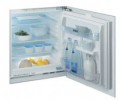Number of shelves
The amount of shelves in a refrigerator determines the division of space within the refrigeration compartment. Larger refrigeration compartments generally have more shelves, but there are also various configurations available even within the same volume (
3 shelves,
4 shelves,
5 shelves and more). It is worth considering that they are mostly removable, which allows you to adjust the height of the shelf. And if necessary, you can buy more.
Energy class
The energy class that the refrigerator corresponds to.
Energy consumption classes were originally designated with Latin letters from
A (the most efficient) to D (least efficient), but with technological advancements, more advanced classes such as "A+", "A++", etc. were introduced to indicate increasing levels of efficiency. The more pluses a device has, the more economical it is. This was necessary due to the correlation between energy consumption and decreasing efficiency.
For modern built-in refrigerators, the efficiency indicator at the level of class A can be called average,
A+ — not bad,
A++ — good,
A+++ — excellent. Energy consumption rates B and C are rare and mostly found in outdated or cheaper models. Achieving high efficiency requires design innovations, which results in higher device prices. However, these prices can be justified by the resulting reduction in electricity bills. It's worth noting that some built-in refrigerator models are available in different energy consumption classes, allowing customers to choose the best option for their budget and energy efficiency needs.
Climate class
This parameter describes the climate conditions for which a particular refrigerator model is designed. A more powerful cooling system and better thermal insulation are required for the refrigerator to operate efficiently in hot conditions compared to low air temperatures. If the refrigerator is not designed for the specific climate conditions it operates in, it may not function efficiently or may even fail.
—
SN (subnormal).Refrigerators of this class are intended for use in temperate climates with relatively low temperatures. They are designed to operate within a temperature range of +10°C to +32°C, which is slightly lower than class N. These refrigerators can be particularly useful in poorly insulated rooms where the temperature can drop below +16°C during the colder seasons.
—
N (normal). Models designed for moderate climate, with ambient temperature from +16 °C to +32 °C.
—
ST (subtropical). Although named after subtropical climates, these models are suitable for both subtropical and tropical climates with high humidity. They can operate within a temperature range of +18°C ... +38°C.
—
T (tropical). Units designed primarily for dry tropical climates. They operate at ambient temperatures from +18 °C to +43 °C.
to the development of refrigerators with combined climate classes and enhanc
...ed features. These models are characterized by both upper and lower classes, such as N-ST, indicating a wider operating range from the lower limit of the lower class to the upper limit of the upper one. For instance, N-ST corresponds to a temperature range of +16...+38 °C. Some models even combine all four classes, such as SN-T, which has an extended range of +10...+43 °C.
With climate change affecting many regions, the introduction of combined climate classes has become increasingly important. In some areas classified as temperate, summers have become hotter while winters remain cold, and a single climate class such as N may not provide adequate coverage for the required temperature range.
